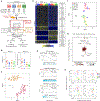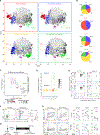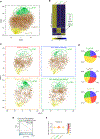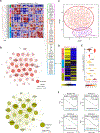Single-cell transcriptomic analysis of allergen-specific T cells in allergy and asthma
- PMID: 32532832
- PMCID: PMC7372639
- DOI: 10.1126/sciimmunol.aba6087
Single-cell transcriptomic analysis of allergen-specific T cells in allergy and asthma
Abstract
CD4+ T helper (TH) cells and regulatory T (Treg) cells that respond to common allergens play an important role in driving and dampening airway inflammation in patients with asthma. Until recently, direct, unbiased molecular analysis of allergen-reactive TH and Treg cells has not been possible. To better understand the diversity of these T cell subsets in allergy and asthma, we analyzed the single-cell transcriptome of ~50,000 house dust mite (HDM) allergen-reactive TH cells and Treg cells from asthmatics with HDM allergy and from three control groups: asthmatics without HDM allergy and nonasthmatics with and without HDM allergy. Our analyses show that HDM allergen-reactive TH and Treg cells are highly heterogeneous and certain subsets are quantitatively and qualitatively different in individuals with HDM-reactive asthma. The number of interleukin-9 (IL-9)-expressing HDM-reactive TH cells is greater in asthmatics with HDM allergy compared with nonasthmatics with HDM allergy, and this IL-9-expressing TH subset displays enhanced pathogenic properties. More HDM-reactive TH and Treg cells expressing the interferon response signature (THIFNR and TregIFNR) are present in asthmatics without HDM allergy compared with those with HDM allergy. In cells from these subsets (THIFNR and TregIFNR), expression of TNFSF10 was enriched; its product, tumor necrosis factor-related apoptosis-inducing ligand, dampens activation of TH cells. These findings suggest that the THIFNR and TregIFNR subsets may dampen allergic responses, which may help explain why only some people develop TH2 responses to nearly ubiquitous allergens.
Copyright © 2020 The Authors, some rights reserved; exclusive licensee American Association for the Advancement of Science. No claim to original U.S. Government Works.
Conflict of interest statement
Figures






References
-
- Miller JD, The Role of Dust Mites in Allergy. Clin Rev Allergy Immunol 57, 312–329 (2019). - PubMed
-
- Larche M, Akdis CA, Valenta R, Immunological mechanisms of allergen-specific immunotherapy. Nat Rev Immunol 6, 761–771 (2006). - PubMed
-
- Kay AB, Allergy and allergic diseases. Second of two parts. N Engl J Med 344, 109–113 (2001). - PubMed
-
- Kay AB, Allergy and allergic diseases. First of two parts. N Engl J Med 344, 30–37 (2001). - PubMed
Publication types
MeSH terms
Substances
Grants and funding
LinkOut - more resources
Full Text Sources
Other Literature Sources
Medical
Molecular Biology Databases
Research Materials

